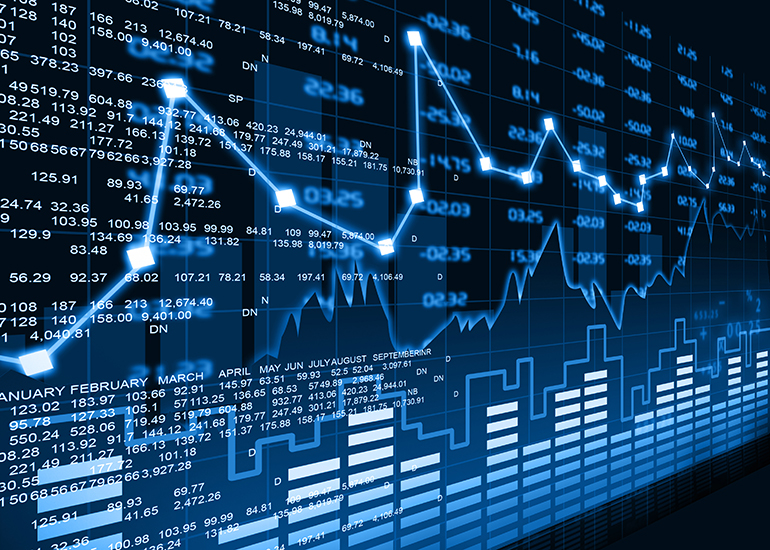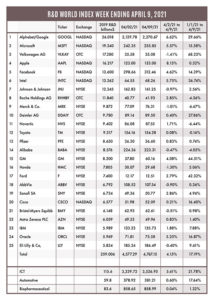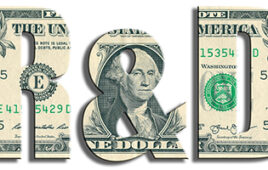
The R&D World Index (RDWI) for the week ending April 9, 2021 closed at 4,767.15 for the 25 companies in the R&D World Index. The Index was up 4.15% (or 189.26 basis points) from the week ending April 2, 2021. The stock of 17 R&D World Index members gained value from 0.08% (Toyota) to 8.13% (Apple). The stock of eight R&D World Index members lost value from -0.40% (Eli Lilly & Co.) to -1.41% (Volkswagen).
In its annual World Economic Outlook released last week, the International Monetary Fund (IMF) raised the global growth rate to 6%, up from the 5.5% growth it projected in January. Then IMF forecasts this growth to moderate to 4.4% in 2022. The pandemic cut global output in 2020 to just 3.3%. The two largest global economies, China and the U.S., will lead this 2021 economic revival with forecast respective growths of 8.4% and 6.4%. India is also forecast to see 12.5% growth in 2021, up from -8% in 2020. The IMF points out that their forecast depends upon the continued path of the pandemic and the effectiveness of policy supports in individual countries. R&D spending is strongly dependent upon GDP growth, and in 2021 also upon continued declines in the pandemic statistics.
The United Kingdom last week also announced that it is launching its Advanced Research & Invention Agency (ARIA), a planned research funding agency of the UK government, similar in scope to the U.S. Department of Defense’s Defense Advanced Research Projects Agency (DARPA). ARIA’s initial budget will be about $1.1 billion over four years and set to begin operating in 2022. ARIA will operate independently of the UK government and be empowered to employ some of the world’s leading and “visionary” researchers. Decisions on its operational portfolio will be set by the agency, not ministers, while funding will be determined by those with relevant technical expertise. While similar operationally to DARPA, ARIA will lack a strong connection to the UK’s Ministry of Defense, but still have strong research programs separate from the UK’s Department for Business, Energy and Industrial Strategy. ARIA will also be exempt from Freedom of Information (FOI) inquiries and from existing Public Contract Regulations that other UK agencies are required to follow.
The U.S. Army announced last week that it will start testing an Army-developed COVID-19 vaccine that its researchers say may protect against a variety of coronavirus variants. Developed at the Walter Reed Army Institute of Research, Silver Spring, Md., initial results of the study could become available by mid-summer 2021. If the results are positive, the Army would likely attempt to join with a commercial drug company to develop the vaccine. The Army researchers say that their vaccine was protective in studies of monkeys exposed to the coronavirus. They also feel that it could be effective against the newer, more transmissible variants of the virus, such as those identified in the UK and South Africa.
Minneapolis-based medical device company Medtronic announced last week the inauguration of its newly expanded 150,000-ft2 Engineering and Innovation Center in Hyderabad, India. The company plans to invest $160 million over the next five years to turn Hyderabad into its largest R&D center outside of the U.S. with a staff of about 1,000 researchers.
RDWI-member AstraZeneca continues to have side-effect issues with its COVID-19 vaccine, specifically with those receiving the vaccine who are under the age of 30. The reactions to the virus include the development of blood clots after vaccination due to the vaccine’s antibody activation of platelets. This reaction is very rare and has appeared at a rate of about one in 100,000 vaccine recipients. European regulators have reviewed 86 of these cases, 18 of which were fatal. However, the risk of the COVID-19 virus itself is lower than the clotting issue, especially in young healthy patients. As such a number of countries have decided to restrict use of the AstraZeneca vaccine to only people over the age of 50 or older. Countries that have restricted the vaccine include Australia, Belgium, Italy, Spain, the UK, Sweden, Denmark, Germany and others. The vaccine has not been submitted for use in the U.S.
Japan’s Hitachi last week announced the purchase of San Jose, Calif.-based GlobalLogic for $9.6 billion. Global Logic is a digital-engineering firm with deep “chip-to-cloud” advanced software product engineering technologies, as well as experience in design skills and vertical industry expertise. With more than 400 clients and 19,000 employees, GlobalLogic is expected to provide big data support for Hitachi’s heavy industry products. Toshiba had more than $2 billion in R&D spending in 2020.
A number of research groups are investigating the long-term effects on those infected with the COVID-19 virus. Research studies have shown that more than 85% of non-hospitalized long COVID-19 patients have experienced four or more neurologic symptoms more than six weeks following post-infection. These symptoms include short-term memory problems, slow mental processing speeds, poor word recall, and difficulties in multitasking. Researchers at Johns Hopkins University, Yale University, Mayo Clinic, Northwestern Memorial Hospital and the Shirley Ryan AbilityLab (Chicago) are all attempting to focus on these neurocognitive disorders and methodologies that can be used to treat/rehabilitate patients. Yale researchers are starting an even longer study (five years) to see if symptoms worsen or develop into persistent brain disorders.
R&D World’s R&D Index is a weekly stock market summary of the top international companies involved in R&D. The top 25 industrial R&D spenders in 2019 were selected based on the latest listings from Schonfeld & Associates’ June 2020 R&D Ratios & Budgets. These 25 companies include pharmaceutical (10 companies), automotive (6 companies) and ICT (9 companies) who invested a cumulative total of nearly 260 billion dollars in R&D in 2019, or approximately 10% of all the R&D spent in the world by government, industries and academia combined, according to R&D World’s 2021 Global R&D Funding Forecast. The stock prices used in the R&D World Index are tabulated from NASDAQ, NYSE and OTC common stock prices for the companies selected at the close of stock trading business on the Friday preceding the online publication of the R&D World Index.



Tell Us What You Think!